The Launch of an Industry

The Prout brothers, Francis and Roland, can lay a claim to being the grandfathers of the cruising catamaran industry.
It is an interesting story of how two brothers came to dominate the cruising catamaran market in the seventies and eighties, before the business finally went under in 2002. along the way, they inspired all sort of people from Dazcat to Lagoon.
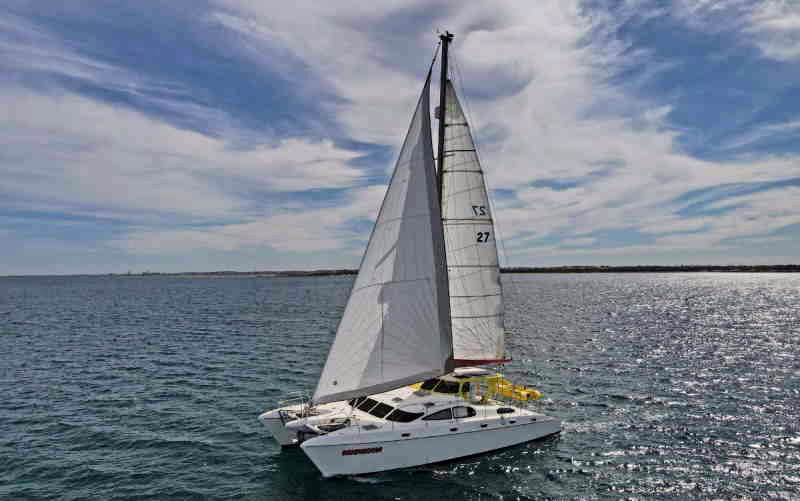
Unfortunately, Prouts are no longer made. For a time, new owners of the name kept the story going, but for now the brand seems to have hit the buffers. But who knows?
If you are looking for a second hand boat, check out our Prout Catamaran for Sale page.
First Steps, Shearwater
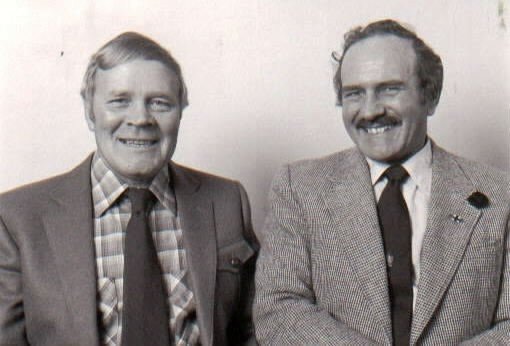 The modern catamaran industry was arguably started by two Essex brothers, with a couple of canoes and some bamboo.
The modern catamaran industry was arguably started by two Essex brothers, with a couple of canoes and some bamboo.
2 Canoes
In the late 1940s and early ’50s, 2 brothers, Francis and Roland Prout were the UK´s top canoeists, and represented Britain in the 1952 Helsinki Olympics.
The brothers worked in the family boat building business, G. Prout & Sons Ltd, making folding canoes and dinghies. The firm had been formed by Geoffrey Prout and his sons, Roland and Francis, in 1935.
After the war, Roland and Francis and their father and mother started up again in a factory at Smallgains Corner. The company grew and hundreds of folding dinghies and canoes were sold all over the world.
Two Hulls Were Faster than One
Roland and Francis had a “Eureka” moment in 1947. What if you lashed two canoes together? Prout catamarans were born.
The Polynesians had thought about it a long time before that, but hey, we’re talking Essex remember! In any case, they weren’t too advanced in yacht manufacturing in the South Seas at that time.
The brothers started experimenting with two Kl racing kayaks tied together with a bamboo platform and adding a mast and sails. The experiment was so successful that the brothers decided to design and build a catamaran, which was called “Shearwater”.
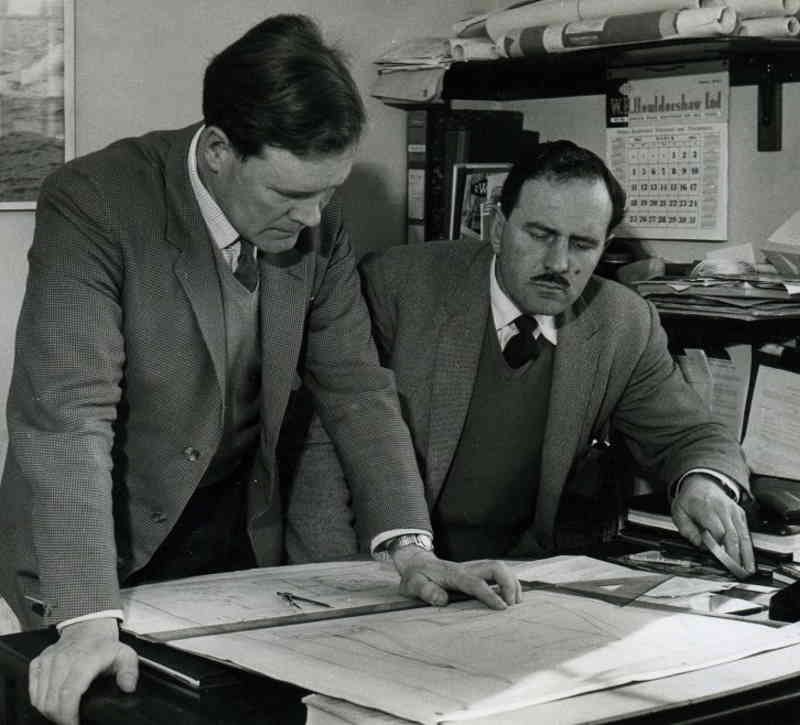
“We shot out of that creek and reached about 15 knots,” said Francis Prout at the time. “It was as if we were on tram lines, turning was difficult because we were going so fast.”
Shearwater: the Legend
This catamaran was known as Shearwater 1, it raced locally and won every race. In 1954 the boat was entered in a “D” class handicap in the Isle of Wight and Burnham regatta week, and won outright.
The Duke of Edinburgh was so impressed with its performance he subsequently bought a Prout catamaran.
This generated lots of interest in catamarans which led to the Prouts designing more models until they hit on the smaller and more easily trailed Shearwater III.
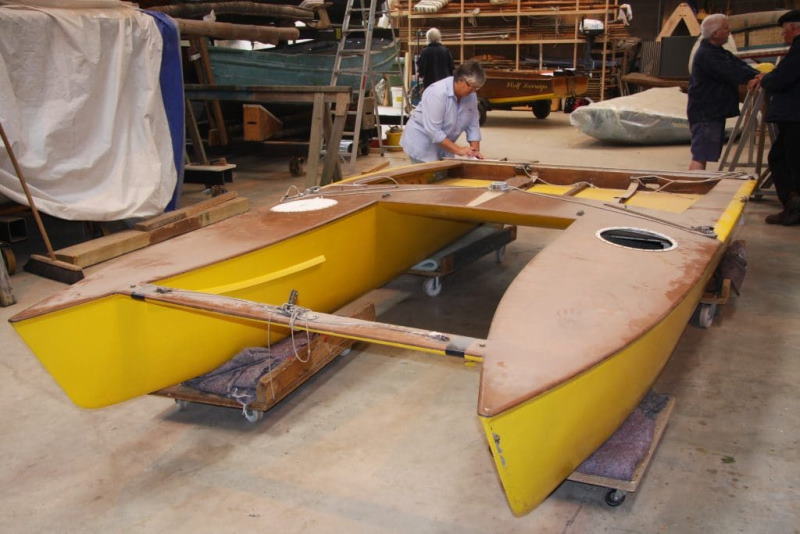
Roland and Francis entered the No I Shearwater III in the first Cross-Channel Dinghy Race from Folkestone to Boulogne in 1956, and beat all of the best racing dinghy helmsmen of the day by over one hour.
This publicity built good demand for the Shearwater III, the world’s first production catamaran. They built over 2000 of them.
The brothers followed up Shearwater with its smaller sister the Swift. And then in 1955, they started to build the 36ft Flamingo cruisers followed by a series of vacuum-bagged, cold-moulded cruisers, including the original SNOWGOOSE built for Don Robertson, chief Test Pilot for de Havilland. When eleven years old, this boat finished second in the Round Britain Race.
Bigger Cats
In the meantime, the Prout Brothers continued to work on new designs, mostly larger craft, including:
The Cougar, a 19ft 2 man catamaran, 27ft and 31ft Ranger Class cruisers, a 45ft Ocean Ranger, and 35 and 37ft cruisers, such as the “Taranga” Class. Prout was the first company to produce fiberglass catamarans.
Launch of a 77 footer: “Tsulamaran”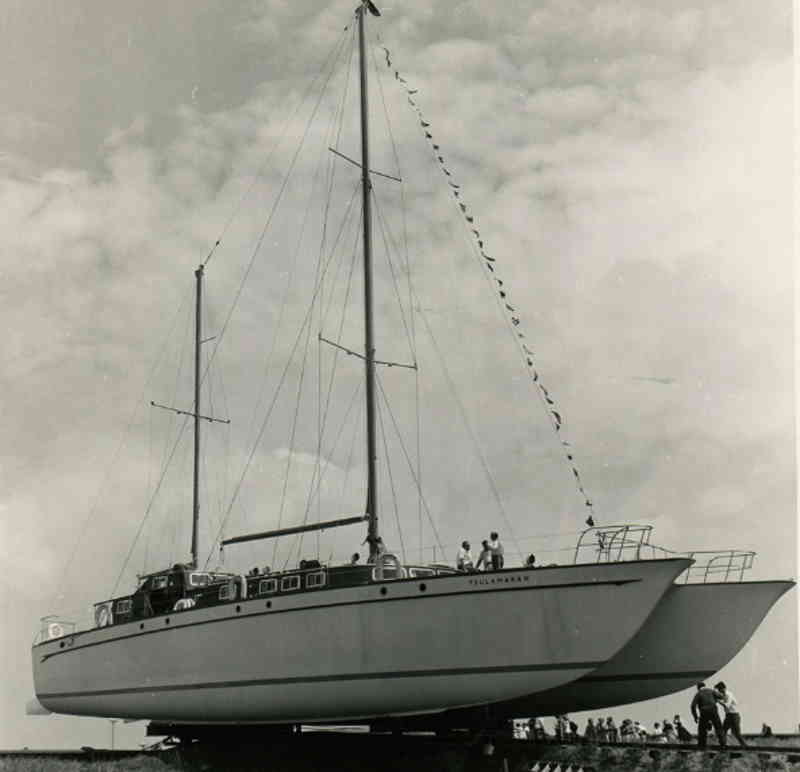
In 1966, a 77 footer called ‘Tsulamaran’, was built: the largest catamaran ever. Prout were ahead of their time on this one. Prout built the first ever catamaran to sail around the world.
Dr. David Lewis’ ‘Rehu Moana’ competed in the 1964 OSTAR, and then went on to complete a circumnavigation.
Snowgoose 35
The first of the more modern designs was the Snowgoose 35, a real innovation at the time in 1971.
The Snowgoose 35 was produced by Thames Marine under license from G. Prout & Sons
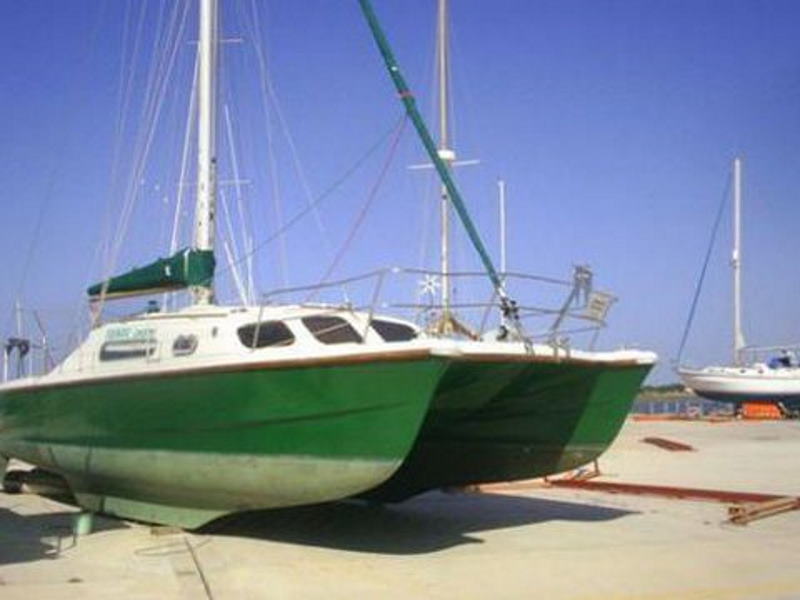
Prout Snowgoose 35
Prout Catamarans Ltd is Born
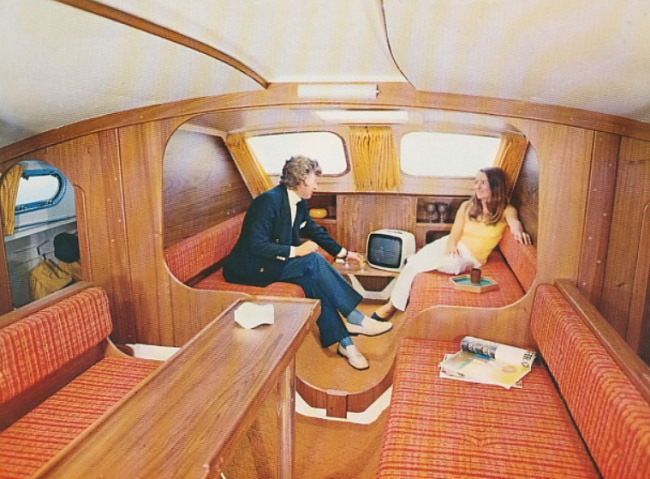
In 1976 a new company was launched with the Prout brothers: Roland and Francis Prout, John and Tom Lawrence, Rodney Hall and Robert Underwood.
The company was known as Prout Catamarans and Robert Underwood was appointed managing director.
Canvey Island
The new company, based on Canvey Island (some seven square miles lying off the South Coast of Essex in the Thames Estuary) was licensed by the Prouts to manufacture, promote and sell their catamaran designs, starting with the Quest 31 and taking on the production of the Snowgoose 35.
In the seventies, the Prout brothers focused on design and soon came up with the Prout Snowgoose 37, Sirocco 26, Quasar 50, Quest 33CS, Quasar 50 S2 and Espace, Snowgoose 37 Elite, Scamper 26 trailer/sailer, Event 34, Escale 39, Prout 45 and finally the Prout 38. Add to that the Panther 44, 61, and 64 power yachts.
It was a time of tremendous growth for the company, but this is also an indication of their inability to streamline their range. This would come to haunt them later (more on that below).
Prout Models, Canvey Island
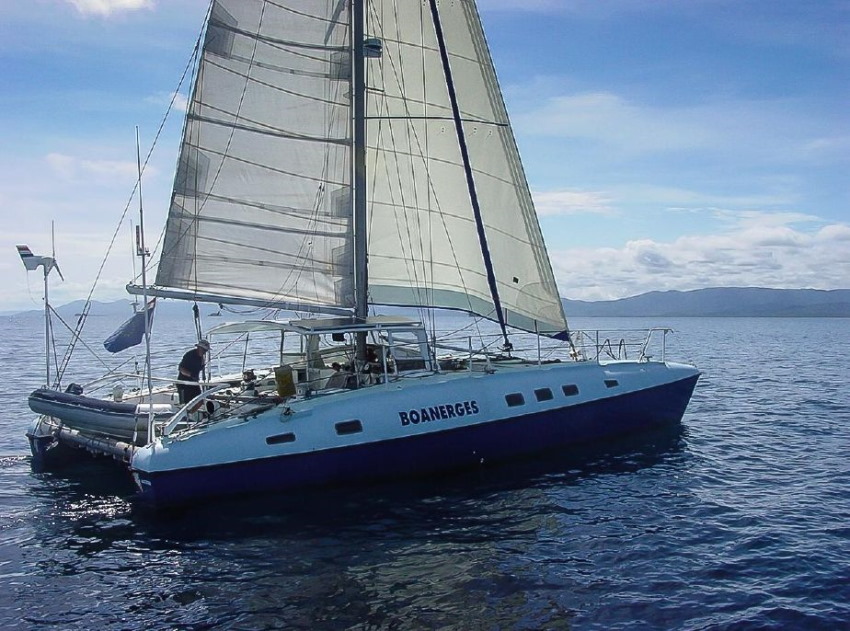
Prout Ranger 45 “Boanerges”
The following yachts were designed and built by the company through the Prout “Golden Years”. Sorted in order of length, not launch date.
- Prout Swift 14’ 6″ racing catamaran (1958)
- Apollo 18 (1969)
- Prout Cougar (1962)
- Prout Ranger 27 – the world’s first all GRP cat (1962)
- Ranger 31 (1963)
- Prout Scirocco 26 (1982)
- Prout Scamper 26 (1983)
- Prout Quest 31 & 33CS (1976 & 1985)
- Prout Event 34 (1989)
- Prout Snowgoose 35 (1969)
- Prout Snowgoose 37 (1978)
- Prout Snowgoose Elite (1986)
- Prout 38 (1998)
- Prout Escale 39 (1990)
- Prout Ranger 45 (1966)
- Prout 45 (1995)
- Prout 46 Ken Freivokh Design (1998)
- Prout Quasar 50 (1979)
- Prout Quasar 50 Espace with high volume hull (1988)
Prout Scirocco 26 (1980)
The smallest of the range (Prout did manufacture a Ranger 27 back in the early sixties), the Scirocco had low-aspect-ratio fixed keels and what they called an “ant-slam nacelle” – something that you can see on modern Lagoon cats to this day.
She had the mast stepped back with a big headsail in the Prout fashion – that kept the pressure off the lee bow.
Prout Scamper 26 (1983)
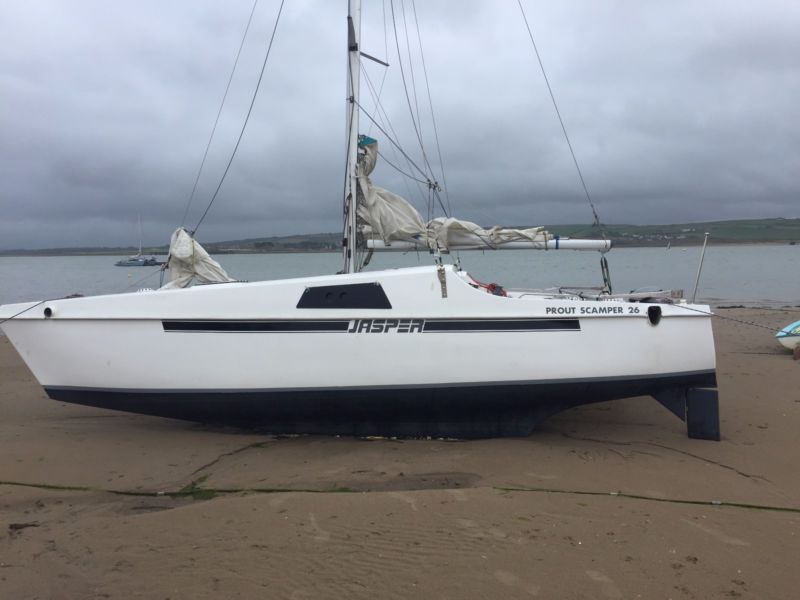
A 26 foot open bridge deck cat, the hulls were built with the Scirocco molds but they added a bigger sail area, a rotating mast and a fully battened sail. She’s a fast coastal cruiser that can be taken apart for trailing.
Many thanks to Martijn from Edam in the Netherlands for sharing his information on the Scamper. Martijn owns one of these coastal cruisers and reckons that Prout built 8 of them.
They went for £9,995 + VAT at the time. An extra £1500 got you a trailer.
Practical Boat Owner Feb 1985: Scamper 26 Review
Yachting World Sep 1984: Scamper 26 Test
Prout Quest 31 (1976) & 33CS (1983)
The Quest 31 launched in 1976 and the new design philosophy was used in the famous Snowgoose 37 launched 2 years later. The Prout brothers often commented that the 31 was the best catamaran they ever made, a decent sailing cat if you keep the weight off, although prone to slamming upwind.
The 33CS was the upgraded design launched in the eighties. I have a soft spot for these Prouts as the first cruising cat I ever sailed on was a Quest 33: “Shady Lady”
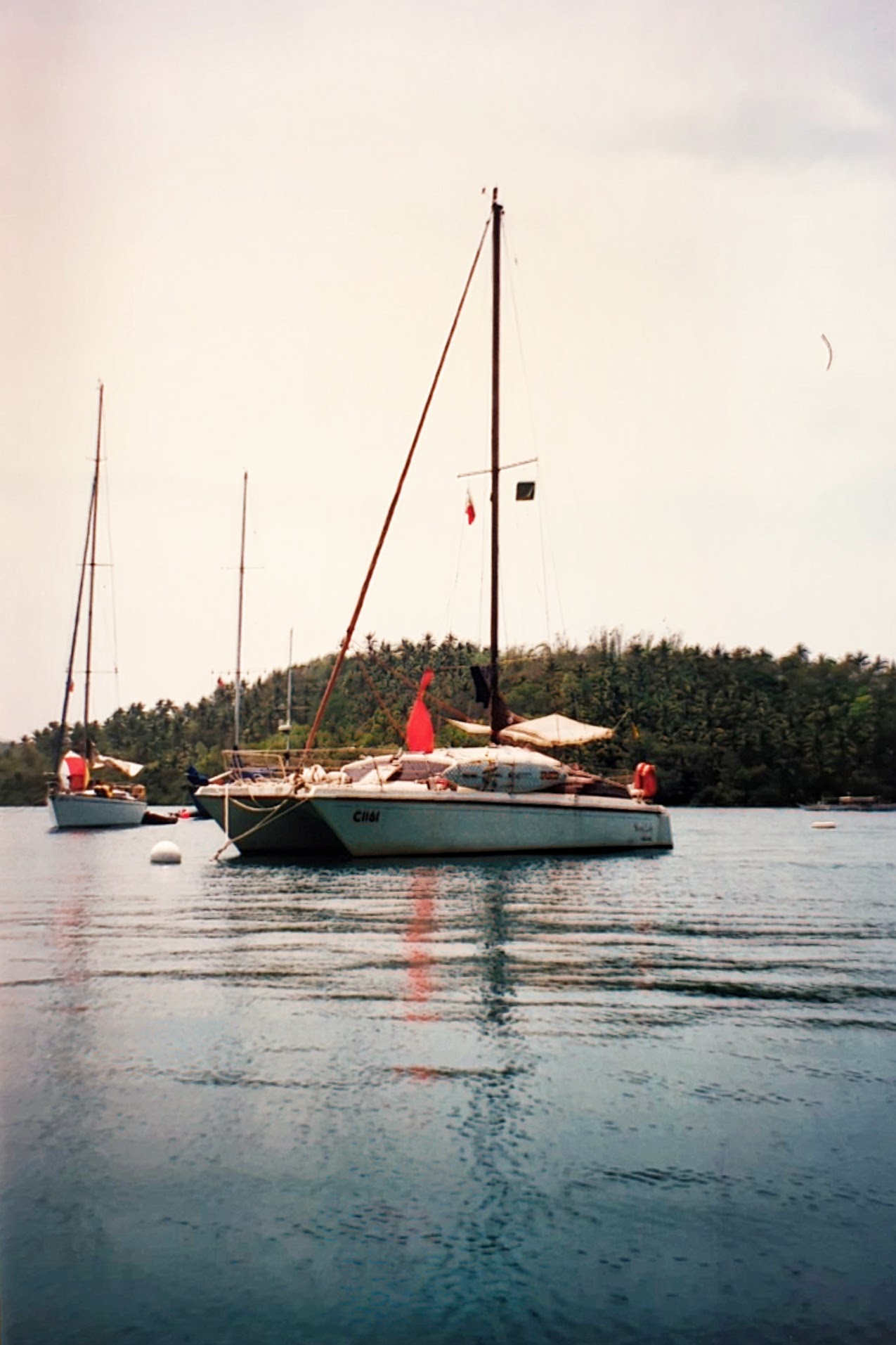 Prout Quest 33 CS. Shady Lady (C1161) from Hebe Haven, Hong Kong.
Prout Quest 33 CS. Shady Lady (C1161) from Hebe Haven, Hong Kong.
Here in Puerto Galera in the Philippines
The 33CS has extensions to make the aft berths almost doubles, but it is heavier.
The Quest is strong and seaworthy, a very easy yacht for soloing. They don’t have much headroom though…
Check out Wolf Hoffman´s blog on “IDA” where he takes her through the Corinth Canal in Greece.
Prout Event 34 (1989)
This model evolved from the popular Quest 33 and came out in ’89. In fact both models were produced at the same time for a while as the Quest 33 had a lower spec and price tag.
A 34 Footer with More Space
She was conceived as a smaller version of the Snowgoose 37 elite, with a similar design philosophy – better load carrying than the Quest and the bump out for a bigger aft cabins. That did slow her down a bit, but she can carry more gear for long passages.
Prout developed the Event 34 from scratch with yacht designer David Feltham. The Event is higher, wider and broader in the stern sections which means more room down below.
The extra volume in the sterns (which end in transoms rather than being canoe shaped) reduce pitching. That trademark Prout nacelle is well developed, almost touching the water at the stern of the boat.
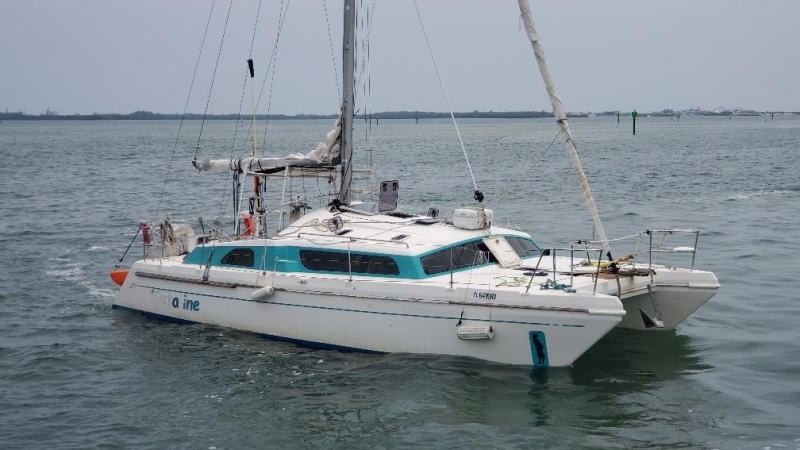
She’s Strong
The hull is a one piece solid molding. It’s a strong, seaworthy boat.
The sail plan is typically Prout with a large low aspect genoa and a small main set (Mainsail) well aft.
She came in the Family Layout with a large double berth at the forward end of the saloon accessed through a dressing room forward in the starboard hull, or the Open Plan Layout with a larger saloon that could be converted into a double berth.
This Prout Event 34 blog is good – a guy sailed his 34 around the British Isles with his dog.
We have heard from Peter Zabell who bought one of the first Event 34 kits from Prout in 1988/1989. His 34, Salt Peter was launched in 1991. He left the UK on her in 1992 to sail around the world and sold her in Australia in 2006.
Snowgoose One Off (1955)
The original Prout Snowgoose was built in 1955 as a one off for Don Robertson, the chief Test Pilot for de Havilland. This was a vacuum-bagged, cold-moulded cruiser.
In 1961, she won the Multihull Round the Island race in a record time of 7 hrs. 46 mins. 51 secs.
Then in 1966, Don’s 36′ Snowgoose came second in the Round Britain Race behind the 42’ ‘Tomi’.
‘Snowgoose’ was the inspiration for the later production series: the 35.
Prout Snowgoose 35 (1969 – 77)
The first production Prout Snowgoose was launched in 1969. Originally it was called a Snowgoose 34, but I guess someone got around to measuring one with the rudders on and they renamed it the Snowgoose 35!
It was the first catamaran to launch with the now famous canoe shaped Prout Nacelle giving you more living space and headroom inside and it allowed an inboard engine with an outdrive leg to be installed.
The all fibreglass Snowgoose 34/35 design was introduced with an Prout offshore rig and low aspect ratio keels.
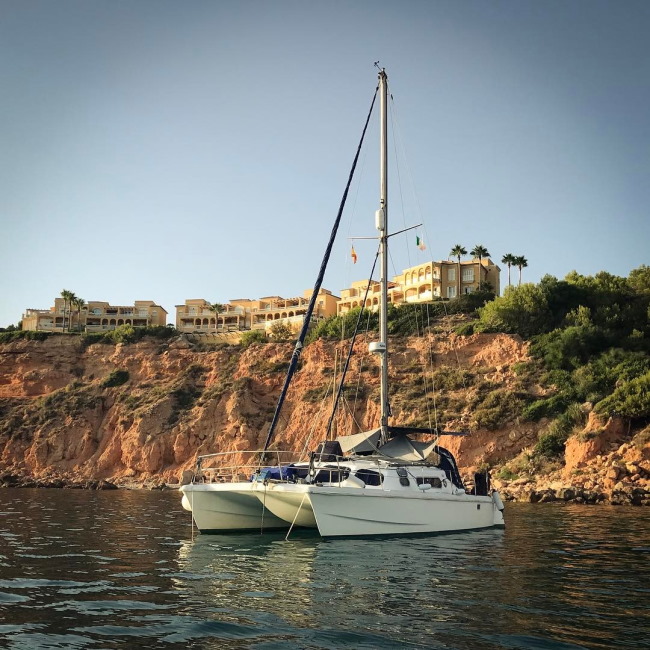
This is Snowgoose 35 “Jade”. Image credit Mike from defylife.com.
The Prout 35 was the first version of the Snowgoose range, at first manufactured by Thames Marine under license from G. Prout & Sons until 1976, and then by Prout Catamarans. She has slender hulls and narrow berths, and is a good sailer but easy to overload.
In 1976, the 35 was replaced with the Snowgoose 37, developed alongside the Quest 31.
Again, this boat had a cutter rig well aft with a low centre of pressure from the sail which resulted in good stability.
The secluded owner’s berth was in the forecabin (something that Privilege cats continue with to this day). She even had flush hatches on the foredeck.
The older Snowgoose cats had slimmer hulls than the 37s and sail faster and point higher. But there is less living space and can´t carry so much weight. If you keep the weight down (particularly off the ends) she will sail well.
With thick, strong hulls and over engineered rigging, she’s another tough boat.
Prout Snowgoose 37 (1978 – 1986 )
The Circumnavigator
The Snowgoose 37 is probably Prout’s most famous boat and the model that has completed the most circumnavigations.
If you sail across the Atlantic from Europe to the Caribbean, there’s a pretty good chance that you will bump into a Snowgoose in a bay or marina somewhere. More than 500 were built, mostly in the eighties. I believe the #1 hull is a yacht called “Cavalier”.
Most Snowgoose 37s have single engines with a rotating, retractable sonic drive gear, typically between 30 and 40HP.
The ‘new’ design was launched in 1978 had more standing headroom and living space with a redesigned berth and galley. The sail plan was improved – the large genoa and small mainsail concept continued.
Read our full Snowgoose 37 review.
Prout Snowgoose 37 Elite (1986 – 2002)
Prout Snowgoose customers had been asking the company for a boat that could carry more weight for longer passages and that had more room down below, especially in the aft cabins, so in 1986, Prout launched an upgraded version of the design called the Snowgoose 37 Elite which was beamier.
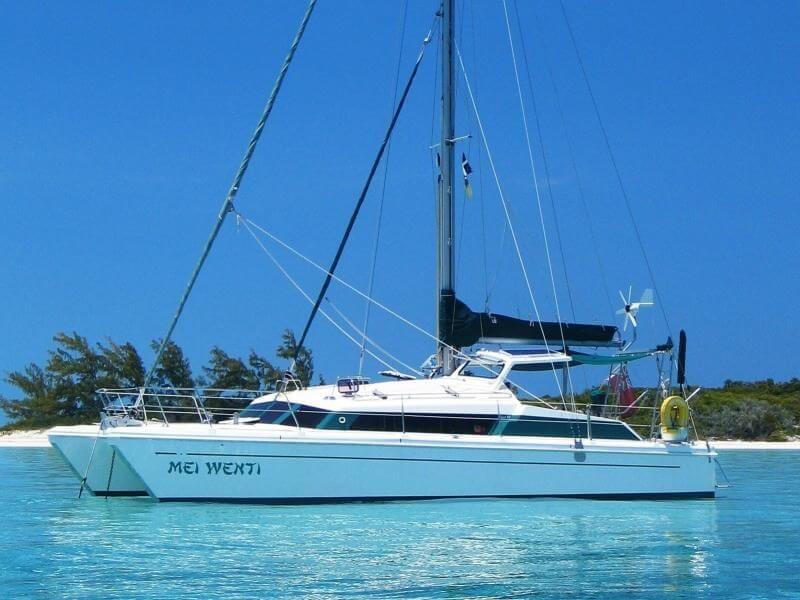
This helped reduce pitching, but she was also heavier and did not perform quite as well up wind as the original 37 (unless the older boat was overloaded).
The 37 Elite has a low bridge deck with a center “nacelle” like many Prouts and there is some “slamming” in rough weather, but you can minimise this with good weight distribution: take off the weight from her ends and she will sail well.
The hull shape of the Elite is slightly different to the original 37. Whereas the standard Snowgoose has two transom-hung outboard rudders, the Elite has slightly smaller rudders below the waterline.
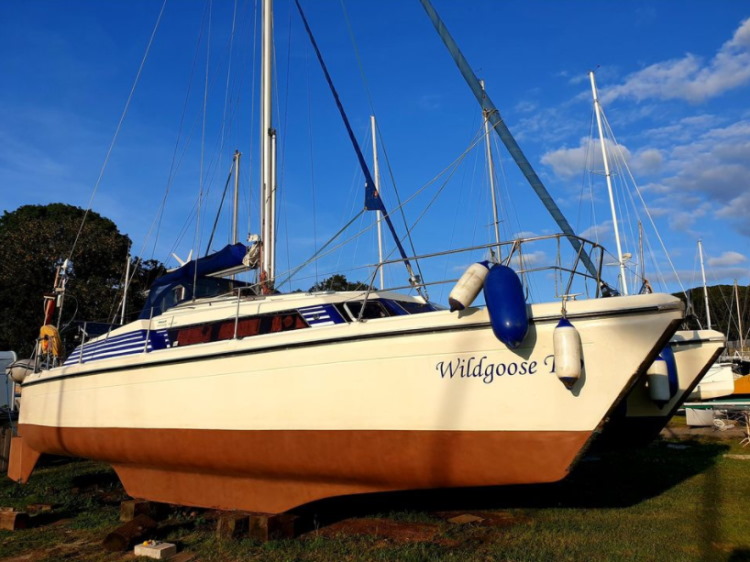
An example of one of these boats is Snowgoose Elite #340 Wildgoose Too (formerly Double Vision) that was launched in 1989
In 1996, Prout announced that they had delivered their 400th Snowgoose.
You can also read our Snowgoose 37 Owner´s Review here.
Prout Snowgoose 37 Elite Brochure
Prout 38 (1998 – 2002)
The Prout 38 was launched in 1998, just 3 years before Prout Catamarans Ltd went into receivership for the first time. Which is a shame, because with this model the UK company really started to find their design feet. You can see a lot of design cues from the larger 45 that was launched 3 years earlier.
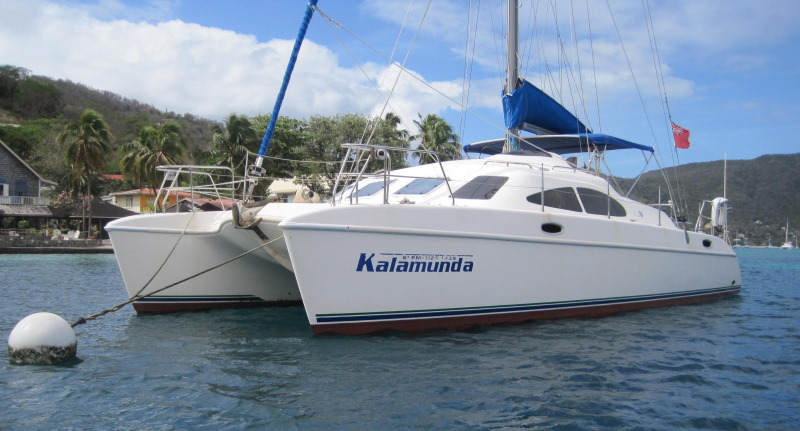
A Pretty Cat
These are no performance cats, but the living space was improved versus the Snowgoose and she carries weight well.
Unlike more modern French designs, you still have to step down to the saloon from the aft cockpit, but on the flip side, it´s pretty cosy when you get in there, and she is a strong, sturdy boat that can handle a blow.
The Prout 38 is not a light boat but follows on in their tradition of strong, sturdy yachts that are easy to sail short handed thanks to the aft position of the mast.
The interior is designed for three couples with one head in the port hull and a “Down Galley” is sunken in the starboard hull with a Cool Box in the forward berth. She´s a good looking catamaran with a high quality, traditional interior finish.
Prout 39 Escale (1991 – 2002 )
The Escale 39 was proportionally wider and roomier than previous Prout designs: the length:beam ratio is about 2:1, similar to most modern cats. This made her more stable, but you lose some of those other Prout benefits like cheaper marina fees and the ability to motor down inland canals. She´s a good load carrier.
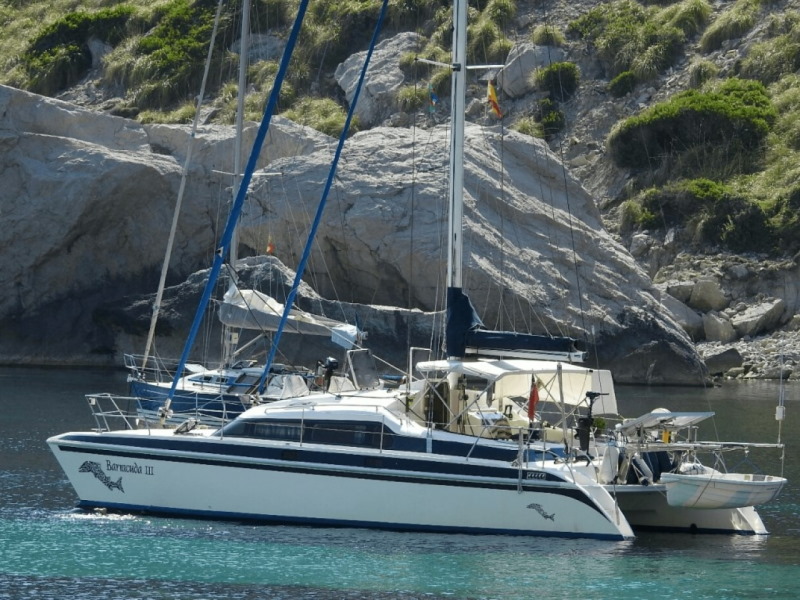
The bridgedeck extends almost to the bows to improve rigidity and living space and she has buoyancy chambers fore and aft for safety.
The Big Nacelle
The famous Prout nacelle was developed further on this boat to increase accommodation and reduce slamming – it’s almost a third hull.
The rig again is comprised of a small high aspect main and large low aspect headsails. The centre of effort is kept low and aft. She’s a fine world cruiser.
Prout 45 (1995) & 46 (1998)
The sleek looking Prout 45 was launched in 1995 following on from the 50 Quasar and was one of their prettiest boats. 3 years later, the Prout 46 was launched with the new 38 which was basically an extended, upgraded version with a high end pack. Read our full Prout 45 Review here.
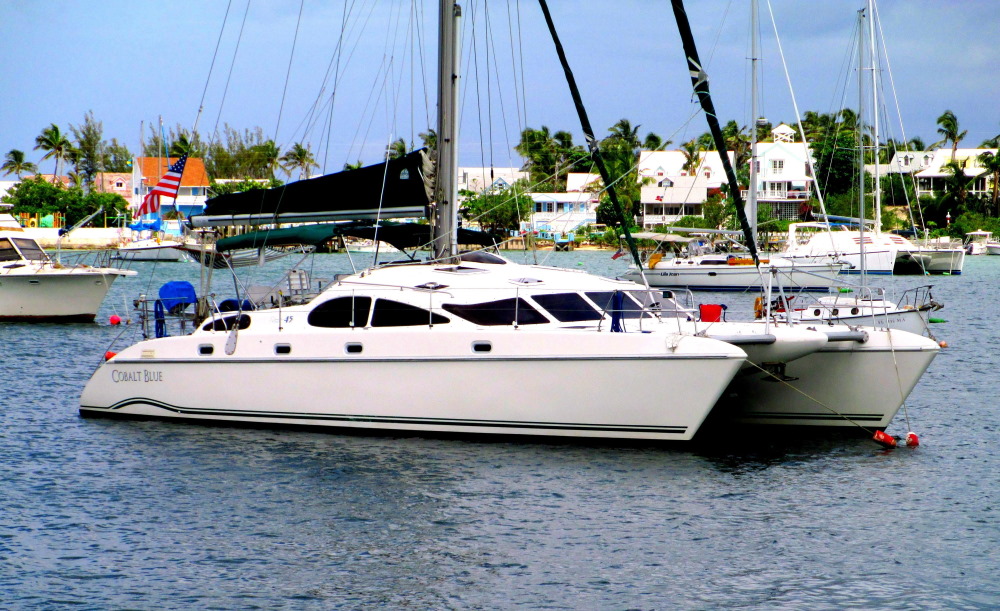
Strong and Sturdy
The 45 is a well made, solid boat. The low bridge deck clearance means there can be a bit of slamming going up wind and the displacement is on the heavy side. You won’t be breaking any speed records, but this is a catamaran that will take you anywhere safely.
The flip side with that lower profile, is that windage is significantly reduced versus other designs. Up front, she looks a bit like a Privilege on the foredeck with those small trampolines and the nacelle. They are very popular boats still that hold their value very well in the second hand market. All the lines come down the aft side of the mast – and because this is positioned aft in the Prout position, your sheets, halyards and reefing lines are all to hand in the cockpit.
Galley Down
With the galley down in the starboard hull, the saloon is very comfortable. In fact the interior design is pretty innovative, an idea that has been continued by Privilege and Lightwave from Australia.
The saloon stops short of the forward bulkhead, so there is space for an owner´s cabin forward in the center of the boat. The Prout nacelle that runs fore and aft along the main deck, adds living space and headroom as well as buoyancy.
The 46 was an interior upgrade. Prout teamed up with Ken Freivokh on this relaunch – these are rare but worth looking out for.
You can also read our Prout 45 Owner’s Review from Sailing Zarafet.
Prout Quasar 50 1979 and Espace (1988)
The Prout Quasar is not the prettiest boat in my personal opinion, but she’s comfortable, stable, and can go through anything. The design evolved from the older Prout Ranger Ocean class, and I have been told that they can move nicely if you keep the weight down and off the ends. They also suffer from wave slam, but these are tough boats that will safely cross oceans.
Plenty of Interior Space
If you are looking for a great value, safe and solid world cruiser, the Prout Quasar 50 is worth a look, especially if you are planning on sailing in colder climes. This boat has pretty much maxed out its interior living space- it´s BIG inside, and even in warmer climes there is plenty of space outside with that solid foredeck.
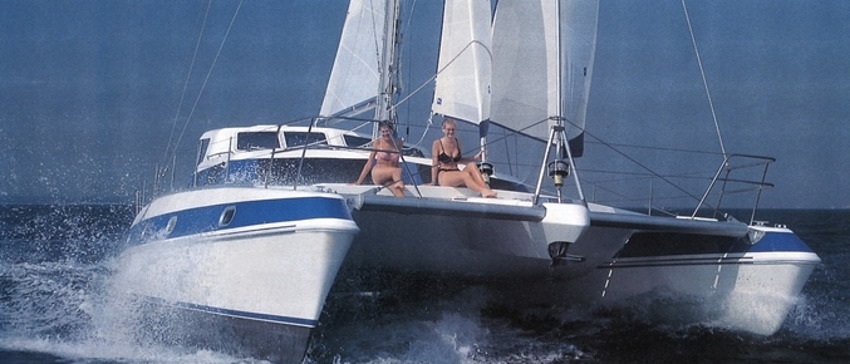
From 1988 onwards, Prout launched the Quasar 50 Espace which added 3 foot onto the beam- that means even more living space, so bear that in mind if you are looking for a good second hand example. Like their other models that had an XL version (eg the Snowgoose Elite), this affected the performance, but it means that the boat can soak up more weight for longer passages.
The Bankruptcy of Prout (2001)
In the late nineties, Prout Catamarans were running into headwinds with currency exchange rates, increased competition and falling demand. Looking at the list of models on sale, it would seem that they weren’t that great at rationalising their product range and increasing production efficiency.
The Quest Years, Limping On
In July 2000, Prout Catamarans was bought by the Quest group, a Canadian company. The plan was to put capital into the business and use Prout Catamarans as the preferred builder for their charter fleet.
They couldn’t turn the loss making business around, however, and Prout Catamarans went into receivership in September 2001, just a year after the purchase. A new Quest subsidiary called Prout UK bought the latest molds, 11 boats under contract, and the employees that they needed. Robert Underwood left towards the end of the year.
In 2002, Prout folded again, this time for good. The company was liquidated and its assets sold, the most valuable of which were the molds.
Broadblue and the South African Connection
After Prout UK went bust, the assets of the company were sold off. Most of the value was in the molds and the brand.
The Molds Travel
The 34, 37, and 39 molds were sold and shipped to South Africa. The newer 38 molds were kept in England and later turned up as the Broadblue 38. One of the directors of Broadblue is Robert Underwood, so I am guessing some kind of deal was done there. There must be more to the story, I might try and bend his ear if I ever see him at a show. Broadblue also got hold of the 46 mold as well, as they sold those in the early 2000s.
You might see 38′ Prout Mantas on the market built in South Africa. They are basically the same boat as the 39 Escale but with shorter sugar scoops. They built around 35 of them, good quality builds in the main.
Prout International
The 45 molds and the Prout brand were bought by a company called Prout International who marketed their boats out of Hong Kong. The company was ultimately owned by a Chinese-Canadian consortium called the Winfair Group I believe. Quest was a subsidiary of the Winfair Group….the plot thickens! I imagine that there was a lot of musical chairs going on so that then assets were offloaded without any debts attached.
The Asian Connection
Manufacturing was initially moved to Thailand (Concordia Yachting Limited), and then to China where Prout International were still selling 60ft+ models until around 2012.
The yard in China was owned by Winfair Marine Ltd in Zhuhai: probably owned by the same person as Prout International: Jack Tse.
They marketed and sold later versions of the 45 called the Prout 45S. They seemed to have ceased trading around 2013 following disputes with both shipyards and customers.
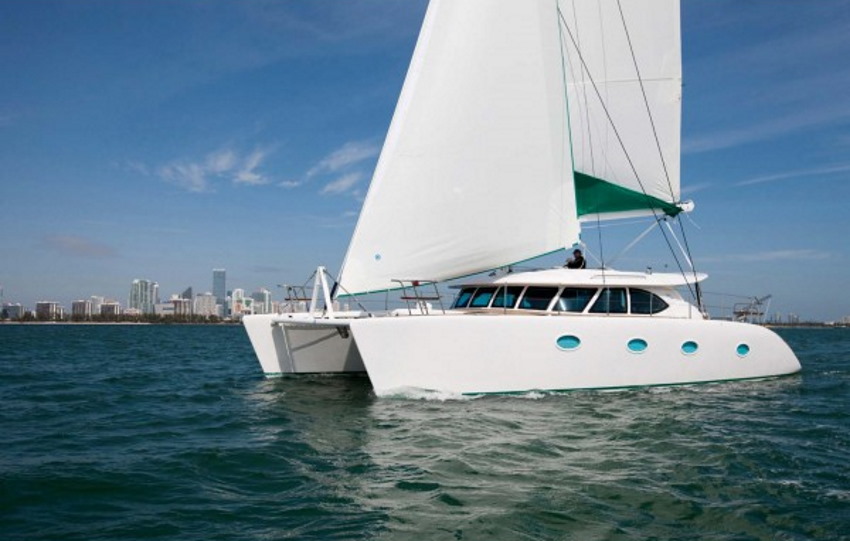
They also built a fifty footer sold as a Prout 50SW and a Dixon designed Prout 72.
Serenity Shipyard in Thailand also seems to have built a few of these Prout International designs (or adaptations)- I am not sure whether they just finished them off here, or they were built from scratch here.
The high water mark for Prout International was the launch of a Prout 77SM in 2013 now called Blue Gryphon. She is available for charter.
Other Brands
Did you enjoy this history of Prout? Please contact us if you have any further information on Prout, we’d love to hear from you.
